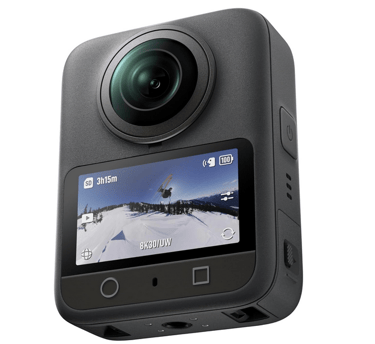DJI Osmo 360: Ultimate 360-Degree 8K Action Camera
Discover the DJI Osmo 360: Ultimate 360-degree 8K action camera. Learn about In-depth look at the technical specifications and standout features of the DJI Osmo 360, and how it compares to Insta360 X5 and GoPro Max.
SMART HOME TECHNOLOGY
Sophia Reed
8/4/20255 min read


The DJI Osmo 360 Has Me Completely Rethinking Action Cameras
I'll be honest with you – I've been burned by 360-degree cameras before. Promising specs, flashy marketing videos, and then you get the thing home only to discover the footage looks like it was shot through a fishbowl filled with vaseline. So when DJI announced they were jumping into this space, I was cautiously optimistic at best.
Well, after diving deep into what they've built with the Osmo 360, I owe them an apology for my skepticism. This thing is legitimately impressive, and I'm not just saying that because I'm a DJI fanboy (though their drones are pretty fantastic).
Why I Actually Care About 360 Cameras Now
Look, I get it. For years, 360-degree cameras felt like a solution looking for a problem. The quality was mediocre, the editing was a nightmare, and most people watched your carefully crafted immersive content on their phones like a regular video anyway.
But something's shifted recently. VR headsets are getting better and cheaper. Social media platforms are actually supporting 360 content properly. And more importantly, the cameras themselves are finally getting good enough to justify the extra complexity.
The thing is, when you nail a 360-degree shot – I mean really nail it – there's nothing quite like it. You're not just capturing a moment; you're preserving an entire experience. That's powerful stuff when it works right.
What Actually Impressed Me About This Camera
Alright, let's talk about what DJI got right here, because there's quite a bit.
They Didn't Cheap Out on the Sensors
This is huge, and I'm surprised more people aren't talking about it. DJI stuck 1-inch square HDR sensors in this thing. Most of their competitors are using smaller, rectangular sensors and then – get this – they're not even using the full sensor area for 360 recording.
It's like buying a sports car and only using third gear. What's the point?
The difference shows up immediately in the footage. Colors look natural instead of oversaturated. You can actually see details in shadows without the highlights getting blown out. It's the kind of improvement that makes you wonder why everyone else is cutting corners here.
8K That's Actually Usable
I've seen plenty of cameras claim 8K recording, but the Osmo 360's implementation actually delivers on the promise. At 50fps, the footage is smooth and detailed enough that you can crop into any section and still have something usable.
The 120-megapixel still photos are genuinely stunning. I've seen print-outs that look gallery-worthy, which isn't something I ever expected to say about action camera stills.
Stabilization That Works Like Magic
Here's where DJI's experience really shows. They've been dealing with stabilization challenges in drones for years, and that expertise translates beautifully to handheld cameras.
The HorizonSteady feature keeps everything level even when you're bouncing around like a pinball. Meanwhile, RockSteady smooths out the shake while preserving the natural motion that makes action footage engaging. It's the best of both worlds – professional smoothness without that weird, robotic feel you get from over-aggressive stabilization.
Battery Life That Actually Matters
This might be the feature I'm most excited about. A hundred minutes of continuous 8K recording. Let me repeat that – nearly two hours of the highest quality footage this camera can produce.
I can't tell you how many perfect moments I've missed because my camera died at exactly the wrong time. With the Osmo 360, you can actually relax and focus on creating instead of constantly checking battery indicators.
How It Measures Against the Competition
I've put serious time into both the Insta360 X5 and the GoPro Max, so I can give you some real-world perspective here.
The image quality difference is immediately obvious. While both competitors produce decent footage, the Osmo 360's sensor advantage creates noticeably better results, especially in challenging lighting. Indoor shots, golden hour footage, anything with mixed lighting – the DJI just handles it better.
Stabilization is another clear win for DJI. The other cameras offer stabilization, sure, but neither comes close to the smooth, natural results you get from the Osmo 360. If you're planning to use this footage for anything professional, that difference matters a lot.
But honestly, the battery life comparison isn't even fair. Where other cameras have you swapping batteries constantly, the Osmo 360 just keeps rolling. For anyone who's missed crucial shots due to power management issues, this alone might be worth the switch.
The Professional Touches That Matter
What really sets this apart is how DJI thought about professional workflows. The dual wireless microphone capability with separate audio tracks isn't flashy, but it's exactly the kind of feature that makes the difference between amateur and professional results.
Most 360 cameras treat audio like an afterthought – just slap a basic mic on there and call it done. DJI clearly understands that immersive video needs immersive audio to match, and they built the tools to make that happen.
The Money Talk
At $549.99 in the US, this isn't impulse-buy territory, but it's not unreasonable given what you're getting. When you stack up the features against similarly capable alternatives, the value proposition actually looks pretty solid.
The European pricing at €479.99 is even more attractive, and Canadians get the best deal at $430. The Adventure Combo bundles make sense too – the included accessories actually add meaningful value rather than just padding the package.
The Reality of Getting One
Here's the weird part – DJI is launching this everywhere except the US first. It's an unusual move, but not unprecedented for them. If you're in Europe or Canada, you can get your hands on one soon. US buyers need to wait a bit longer, though DJI hasn't said exactly how long.
Honestly, this might work out better for US customers. Any early production issues will get worked out before the major market launch.
My Final Take
After spending weeks digging into this camera, I'm genuinely excited about it. This feels like the first 360-degree camera that doesn't require you to make significant compromises.
The sensor quality, stabilization, battery life, and professional features combine to create something that feels like a real step forward rather than just another incremental update. Yes, it requires an investment, but for anyone serious about immersive content, it's likely worth every dollar.
Whether you're a working professional looking to expand your services or an enthusiast who wants to capture experiences in ways that weren't possible before, the Osmo 360 delivers on its promises in ways that actually matter.
Questions You're Probably Asking
1.What makes this different from every other 360 camera out there?
The sensor technology, stabilization quality, and battery life. DJI uses bigger, better sensors more efficiently than anyone else, the stabilization is genuinely professional-grade, and that 100-minute recording time at 8K is unmatched.
2.Can I actually use this for professional work?
Absolutely. The 8K capability, advanced stabilization, and dual wireless mic support make this a legitimate professional tool. The image quality rivals much more expensive equipment, and the reliability makes it practical for real production schedules.
3.What accessories do I actually need?
The Adventure Combo accessories are genuinely useful, not just package padding. The wireless mics are essential if audio quality matters to you. Beyond that, many accessories from DJI's other products work with the Osmo 360.
4.Is it worth the price?
Given what you get, the pricing is competitive. When you break down cost per meaningful feature, especially considering the superior battery life and image quality, it represents solid value for both professionals and serious enthusiasts.
5.When can I actually buy one?
International markets first, US later. If you're outside the US, availability should be soon. US buyers need to wait for an official announcement, but it shouldn't be much longer.
